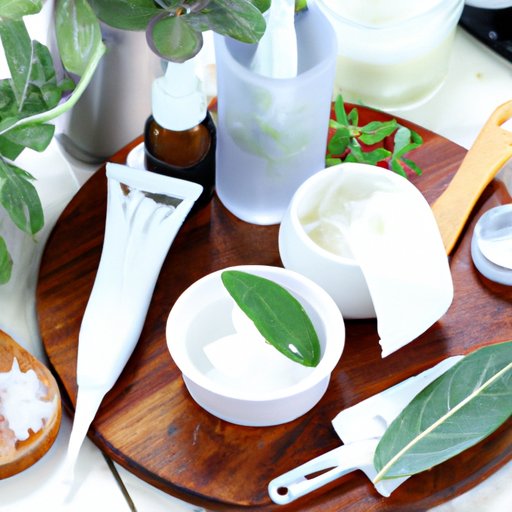
Introduction
Seborrheic keratosis is a common, non-cancerous skin growth that can be unsightly and bothersome for some people. While it’s usually harmless, many people want to remove them for cosmetic reasons. Fortunately, there are several safe and effective ways to remove seborrheic keratosis at home without resorting to expensive medical procedures. In this article, we will explore natural remedies, DIY freezing kits, and over-the-counter creams for seborrheic keratosis removal, as well as tips for preventing and caring for the skin after treatment.
Natural Remedies for Removing Seborrheic Keratosis
If you prefer non-invasive, chemical-free solutions, natural remedies may be a good choice for removing seborrheic keratosis. Apple cider vinegar, tea tree oil, aloe vera, and coconut oil are all natural ingredients that have been shown to be effective in removing seborrheic keratosis. To use apple cider vinegar or tea tree oil, simply apply a small amount to the affected area using a cotton swab twice a day until the growth falls off. Aloe vera and coconut oil can be applied directly to the growth and left on overnight. While natural remedies are generally safe, it’s important to be aware of any potential allergies or sensitivities to these ingredients, and to note that results may vary. Additionally, some people may experience redness, irritation, or burning when using natural remedies to treat their seborrheic keratosis.
DIY Freezing Kits for Seborrheic Keratosis Removal
Cryotherapy, or freezing, is a common medical treatment for seborrheic keratosis. DIY freezing kits, such as Dr. Scholl’s Freeze Away and Compound W Freeze Off, are available at most drugstores and can be used at home with caution. To use these kits, simply apply the freezing solution to the affected area for the recommended amount of time as instructed on the package. It’s important to follow the instructions carefully to avoid damaging the surrounding skin. While DIY freezing kits can be an effective and affordable option for removing seborrheic keratosis, it’s important to note that they may not be suitable for all skin types or growths. Furthermore, DIY freezing kits can carry a small risk of scarring, infection, or nerve damage, so it’s important to contact a doctor if you experience any post-treatment complications.
Over-the-Counter Creams for Seborrheic Keratosis Removal
If you’re looking for a less painful and more convenient alternative to cryotherapy, over-the-counter creams might be the solution for you. SeroVital Skin Restore, Skinprov Advanced, and Terrasil Skin Repair are all popular over-the-counter creams that have been shown to be effective in removing seborrheic keratosis. Applying the cream directly to the growth twice a day can help to dissolve the growth over time. While over-the-counter creams are generally safe and affordable, it’s important to choose the right cream based on personal preference and skin type, and to be aware of any potential side effects or risks. Some people may experience burning, stinging, or itching when using these creams, and they may not be suitable for pregnant women or people with certain medical conditions.
Home Remedies for Preventing Seborrheic Keratosis
The best way to avoid dealing with seborrheic keratosis is to prevent it from appearing in the first place. To reduce your risk, it’s important to maintain healthy skin habits, such as avoiding sun damage and building a good skincare routine. To avoid sun damage, be sure to wear sunscreen with a high SPF, wear a hat and protective clothing, and avoid spending too much time in direct sunlight. Additionally, make sure to cleanse, moisturize, and exfoliate your skin regularly to keep it healthy and free of growths.
Self-Care Tips After Seborrheic Keratosis Removal
After treating seborrheic keratosis, it’s important to take care of your skin to promote healing and minimize scarring. Make sure to keep the affected area clean and moisturized, and avoid activities that could irritate the skin, such as swimming or excessive sweating. Additionally, it’s important to apply sunscreen to the treated area to avoid sun damage and further growths.
Conclusion
Seborrheic keratosis can be safely and effectively removed at home using natural remedies, DIY freezing kits, and over-the-counter creams. Additionally, maintaining healthy skin habits can help to prevent seborrheic keratosis from appearing or reappearing after treatment. While these methods are generally safe and affordable, it’s important to be aware of potential side effects and risks, and to contact a doctor if you have any concerns or questions about your skin health.





